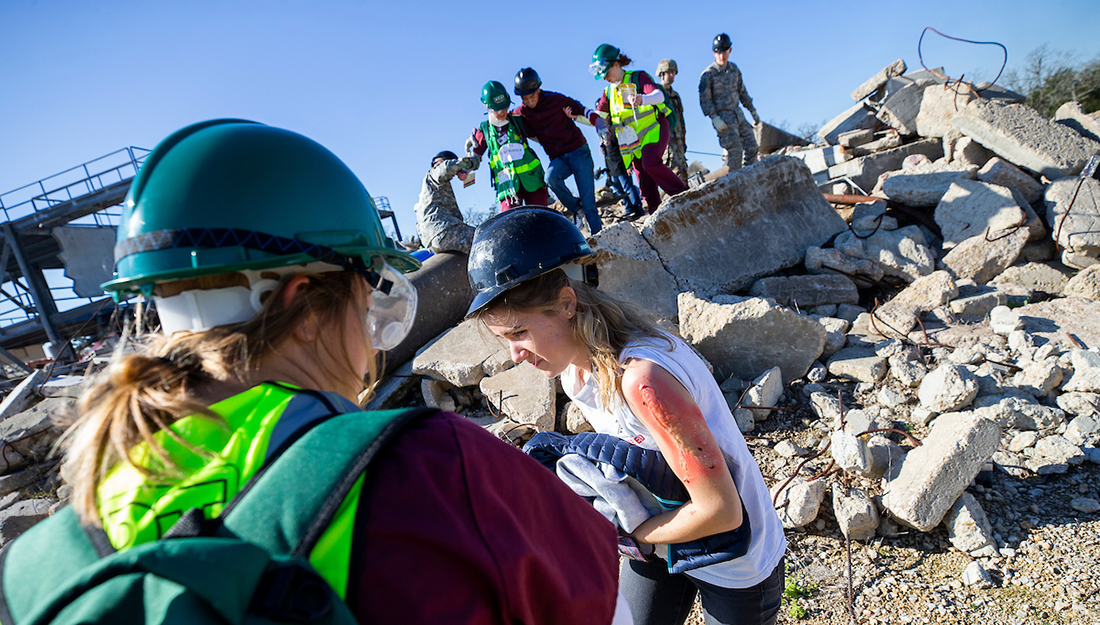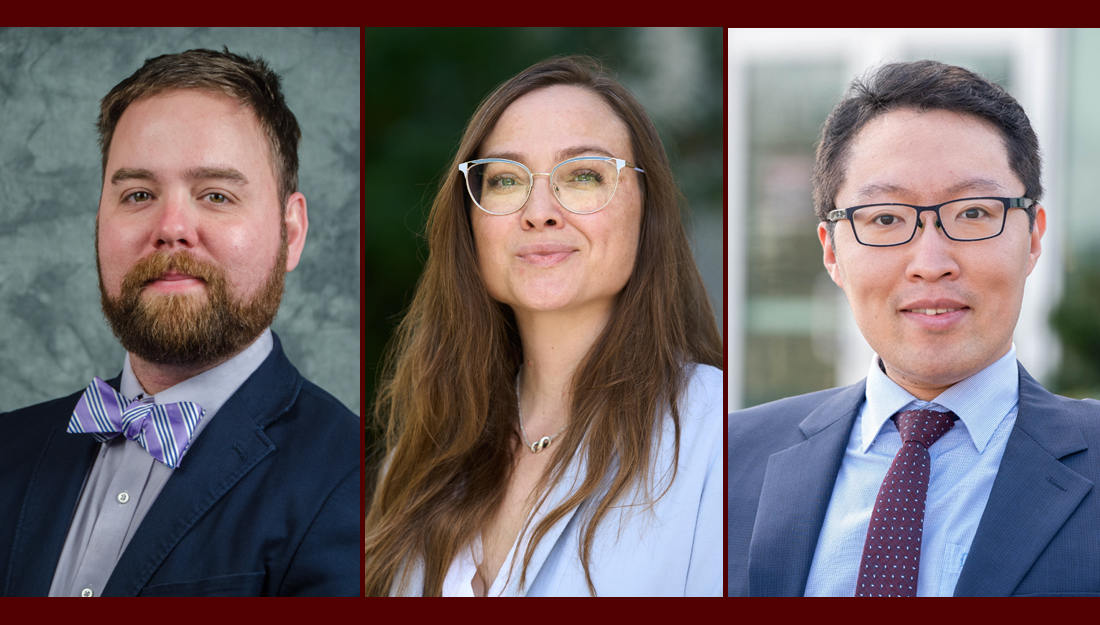- Lindsey Hendrix
- Editor's Pick, Featured, Medicine, Nursing, Pharmacy, Public Health, Show on VR homepage
Mass disaster simulation prepares health professions students for the worst
Students plan, coordinate and take part in the nation’s largest interprofessional disaster response simulation

Images of the Texas A&M Health Disaster Day event held on Friday, Feb. 14, 2020. (Sam Craft/Texas A&M University Division of Marketing & Communications)
With Texas’s sheer size, it should come as no surprise that the Lone Star State has the highest frequency of extreme weather events in the United States. From hurricanes along the Gulf Coast and tornadoes in the Panhandle, to explosions at industrial plants and mass human violence, disaster can strike—and has—at almost any place and time. It’s because of this high risk that Texas is well prepared to respond and recover, and, thanks to Texas A&M University, our future health professionals are no exception.
Texas A&M University Health Science Center (Texas A&M Health) today conducted the largest student-led interprofessional disaster response simulation in the nation. Aptly called Disaster Day, this large-scale drill teaches health professions students how to work collaboratively to manage disasters and provide timely and appropriate patient care.
Disaster Day was created by the Texas A&M College of Nursing in 2008 and is now facilitated through the Texas A&M Health Office of Interprofessional Education and Research (IPER). Now in its twelfth year, students from across Texas A&M Health at the colleges of nursing, medicine, pharmacy and public health, as well as psychology and veterinary students and the Corps of Cadets, take part in the one-day event. It is held at Texas A&M Engineering Extension Service’s (TEEX) Brayton Fire Training Field and Disaster City, a world class, 52-acre mock city that serves as a training facility for emergency responders.
“We are very fortunate here in Bryan-College Station to be in close proximity to one of the best training facilities in the nation for first responders, where entities from around the world come to train,” said Martin Mufich, MSN, RN, CHSE, director of disaster preparedness, response and recovery in the IPER office at Texas A&M Health. “In addition, Texas A&M is home to the Texas Division of Emergency Management and Texas A&M Task Force 1, one of 28 federal teams under the Federal Emergency Management Agency’s (FEMA) National Urban Search and Rescue System.”
For the live action simulation, a new scenario is selected each year and kept secret until event day to provide the realism of an unexpected situation. Last year’s event was a chemical explosion and building collapse, and this year’s event simulated an earthquake where more than 700 students engaged in triage at the disaster site, patient care at a mock field hospital, and disaster management and simulation oversight at Disaster City’s Emergency Operations Training Center.
The students had to react to mass “injuries,” with other students in makeup portraying victims with various degrees of wounds, from cuts to compound fractures. The students mimicked panicked patients as they screamed, cried and pleaded for help. At the end of each exercise, instructors and other observers critiqued student teams on their clinical skills, teamwork and communication to help improve their skills for a real-life disaster and their practice after graduation.
“It takes students out of their usual clinical element and makes them think quickly in what can be an uncomfortable environment,” Mufich said. “Practicing this way is valuable because these situations can happen in the real world.”
Nicole Mancuso, a graduate of the College of Nursing, can attest to this. She was working in a Las Vegas emergency room during the mass shooting on the Las Vegas strip in October 2017. “It was complete chaos—we had people come in from the lobby, along with those brought in by emergency medical services,” Mancuso said. “High adrenaline and a sense of duty helped me keep my composure. You have to stay calm in these situations, for the sake of the patient.” She credits her training at the college and involvement in Disaster Day for teaching her how to appropriately triage and treat patients in mass casualty scenarios. “Having the knowledge of triaging really helped to know who needs more time from me and who is okay in comparison. What I learned at the college built my initial skills to become an emergency room nurse.”
Not only do students take part in the immense Disaster Day simulation, they are also responsible for coordinating and executing it. With oversight from a faculty steering committee and in coordination with the IPER office, about 60 students make up the Disaster Day Student Planning Committee (SPC), which is composed in approximation to the FEMA model for incident command.
“When disaster strikes, incredible coordination between groups and people is required by working under intense pressure to care for those in need,” said Greg Hartman, interim senior vice president of Texas A&M Health. “Disaster Day simulates this level of coordination—from planning through execution—to better prepare our students.”
“Our faculty, staff and students have worked hard to ensure a realistic disaster simulation and that interprofessionalism—where students learn with, from and about each other to cultivate collaborative skills—is woven into this event at all levels with intentionality,” said Christine L. Kaunas, executive director of IPER. “This event provides opportunities to hone critical disaster response skills, but ultimately, it is about training students from multiple health professions together, which prepares them to provide better care for patients and populations upon graduation.”
H-E-B once again participated in Disaster Day with a team from the company’s San Antonio headquarters providing meals to simulation participants using one of the mobile cooking facilities they deploy in real emergencies. Other participating organizations were the American Red Cross, Southwest Texas Regional Advisory Council, Texas Department of Emergency Management, Texas Department of State Health Services, Texas State Guard, Texas A&M Corps of Cadets, Texas A&M Engineering Extension Services, Texas A&M Mays Business School, Texas A&M Telebehavioral Care, Texas A&M University Superfund Research Center and Texas A&M Veterinary Medicine and Biomedical Science.
Educating the whole community
For security and logistical reasons, the Disaster Day simulation is open specifically to Texas A&M Health students and their partners; however, in an effort to expand education to the community, for the first time, the SPC organized additional disaster preparedness activities that took place throughout the week leading up to this year’s Disaster Day.
Disaster Week 2020 kicked off on Monday with the Texas A&M University Superfund Research Center’s free, community-wide event called “Plan Ahead, Be Prepared” that included exhibits from local, state and national disaster response and recovery agencies to provide information and tools to prepare for natural disasters. The event also included a blood drive. On Tuesday, a variety of trainings relevant to disasters and other emergencies were provided, including a Stop the Bleed course and a mass opioid overdose reversal training, where an estimated 413 people learned how to recognize an opioid overdose and administer naloxone to reverse deadly effects. Texas A&M Health students, first responders and the community were also invited to learn how to access, utilize and apply disaster related resources available from the National Library of Medicine (NLM) through the new “ReDiReCT” (Integrating NLM Resources into Disaster Preparedness and Response Cross-Disciplinary Training) disaster application portal.
The Texas A&M Disaster Management Symposium, sponsored by Aggreko, was held on Wednesday and featured a poster session and keynote presentation by W. Nim Kidd, vice chancellor of disaster and emergency services at The Texas A&M University System and chief of the Texas Division of Emergency Management (TDEM). International disaster management guests also contributed to a panel discussion. On Thursday, emergency response equipment from TDEM, the Texas A&M Forestry Service and the U.S. Army was on display in Kyle Plaza.
“Our goal for the future is to incorporate more interprofessional emergency response education opportunities for our health professions students throughout the year,” Mufich said. “As we better align with professional first responders, continue to grow and try to get more knowledge out there, we will begin integrating additional modalities for training our students, such as tabletop discussions, lectures and focused simulations that allow for more in-depth education.”
Media contact: media@tamu.edu


